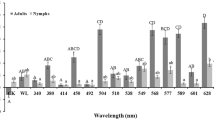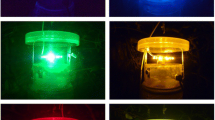Abstract
In recent years, light traps with light-emitting diodes (LEDs) have been widely used in integrated pest management. The spiralling whitefly, Aleurodicus dispersus Russell, a highly invasive pest which causes heavy damage to fruit trees and ornamental plants, exhibits positive phototaxis, and light trap is the most appropriate tool for monitoring. We evaluated the use of LEDs as an inexpensive light source and examined the relationship between the captured number and the population density of adult A. dispersus in the field. We found that the violet (405 nm) LED traps captured the most adults of A. dispersus, and the captured numbers were significantly higher than those of blue (460 nm), green (520 nm), yellow (570 nm), and red (650 nm) LED traps. The adults of A. dispersus captured by light traps equipped with violet LEDs and smeared with liquid paraffin had a significant positive correlation with the population density of adult A. dispersus in a guava orchard, with a correlation coefficient of 0.828. In general, the light traps with 15 violet LED bulbs hung into 550-mL plastic bottles and smeared with liquid paraffin were the portable devices for attraction of adult A. dispersus. The results have potential use for improving the efficiency of light traps at attracting and trapping the adult spiralling whitefly.




Similar content being viewed by others
References
Affeldt HA, Thimijan RW, Smith FF, Webb RE (1983) Response of the greenhouse whitefly (Homoptera: Aleyrodidae) and the vegetable leafminer (Diptera: Agromyzidae) to photospectra. J Econ Entomol 76:1405–1409
Antignus Y (2000) Manipulation of wavelength-dependent behaviour of insects: an IPM tool to impede insects and restrict epidemics of insect-borne viruses. Virus Res 71(2000):213–220
Bentley MT, Kaufman PE, Kline DL, Hogsette JA (2009) Response of adult mosquitoes to light-emitting diodes placed in resting boxes and in the field. J Am Mosq Control Assoc 25(3):285–291
Bishop AL, Worrall BJ, Spohr LJ, McKenzie HJ, Barchia IM (2004) Improving light-trap efficiency for Culicoides spp. with light-emitting diodes. Vet Ital 40(3):266–269
Briscoe AD, Chittka L (2001) The evolution of color vision in insects. Annu Rev Entomol 46:471–510
Burkett DA, Butler JF, Kline DL (1998) Field evaluation of colored light-emitting diodes as attractants for woodland mosquitoes and other Diptera in north central Florida. J Am Mosq Control Assoc 14(2):186–195
Chu CC, Simmons AM, Chen TY (2004) Lime green light-emitting diode equipped yellow sticky card traps for monitoring whiteflies, aphids and fungus gnats in greenhouses. Entomol Sin 22(2):125–133
Cinzana P, Falchi F, Elvidge CD (2001) The first world atlas of the artificial night sky brightness. Mon Not R Astron Soc 328:689–707
Cohnstaedt L, Gillen JI, Munstermann LE (2008) Light-emitting diode technology improves insect trapping. J Am Mosq Control Assoc 24(2):331–334
Cowan T, Gries G (2009) Ultraviolet and violet light: attractive orientation cues for the Indian meal moth, Plodia interpunctella. Entomologia Experimentalis et Applicata 131:148–158
Dreisig H (1980) The importance of illumination level in the daily onset of flight activity in nocturnal moths. Physiol Entomol 5:327–342
Duehl AJ, Arbogast RT, Sheridan AB, Teal PEA (2012) The influence of light on small hive beetle (Aethina tumida) behavior and trap capture. Apidologie 43:417–424
Duehl AJ, Cohnstaedt LW, Arbogast RT, Teal PEA (2011) Evaluating light attraction to increase trap efficiency for Tribolium castaneum (Coleoptera: Tenebrionidae). J Econ Entomol 104(4):1430–1435
Garstang RH (2004) Mount Wilson observatory: the sad story of light pollution. Observatory 124:14–21
Han DY, Liu K, Chen W, Fan ZW (2008) Distribution and host plants of spiralling whitefly, Aleurodicus dispersus, in Hainan. Chin Bull Entomol 45:583–588
Hoel DF, Butler JF, Fawaz EY, Watany N, El-Hossary SS, Villinski J (2007) Response of phlebotomine sand flies to light-emitting diode-modified light traps in southern Egypt. J Vector Ecol 32(2):302–308
Hollingsworth JP, Wright RL, Lindquist PA (1964) Radiant-energy attractants for insects. Agric Eng 45:314–317
Land MF (1997) Visual acuity in insects. Annu Rev Entomol 42:147–177
Mound LA (1962) Studies on the olfaction and colour sensitivity of Bemisia tabaci (Genn.) (Homoptera, Aleurodidae). Entomologia Experimentalis et Applicata 5:99–104
Mutwiwa UN, Tantau HJ (2005) Suitability of a UV lamp for trapping the greenhouse whitefly Trialeurodes vaporariorum Westwood (Hom: Aleyrodidae). Agric Eng Int: CIGR Ejournal 7:1–11
Nakamoto Y, Kuba H (2004) The effectiveness of a green light emitting diode (LED) trap at capturing the West Indian sweet potato weevil, Euscepes postfasciatus (Fairmaire) (Coleoptera: Curculionidae) in a sweet potato field. Appl Entomol Zool 39(3):491–495
Persson B (1971) Influence of light of flight activity of noctuids (Lepidotera) in south Sweden. Entomol Scan 2:215–232
Ren XH, Wang YB (2008) Field experiment on inducing insect by colorful plate with water-soluble. J Anhui Agric Sci 36(14):6065–6067
Russell LM (1965) A new species of Aleurodicus Douglas and two close relatives (Homoptera: Aleyrodidae). Fla Entomol 48:47–55
Sambaraju KR, Phillips TW (2008) Responses of adult Plodia interpunctella (Hübner) (Lepidoptera: Pyralidae) to light and combinations of attractants and light. J Insect Behav 21:422–439
Sivinski JM (1998) Phototropism, bioluminescence, and the Diptera. Fla Entomol 81:282–292
Srinivasa MV (2000) Host plants of the spiraling whitefly Aleurodicus dispersus Russell (Hemiptera: Aleyrodidae). Pest Manag Hortic Ecosyst 6:79–105
Srinivasan G, Mohanasundaram M (1997) A novel method to trap the spiralling whitefly Aleurodicus dispersus Russell adults in the home gardens. Insect Environ 3(1):18
Tamulaitis G, Duchovskis P, Bliznikas Z, Breivë K, Ulinskaitë R, Brazaitytë A, Novièkovas A, Pukauskas A (2005) High-power light-emitting diode based facility for plant cultivation. J Phys D Appl Phys 38(17):3182–3187
Ting YC, Kao WT, Li DM (1974) Study on the phototactic behavior of nocturnal moths: the response of Heliothis armigera (Hübner) and Heliothis assulta Guenée to different monochromatic light. Acta Entomol Sin 17(3):307–316
Vaishampayan SM, Kogan M, Waldbauer GP, Wooley JT (1975) Spectral specific responses in the visual behaviour of the greenhouse whitefly, Trialeurodes vaporariorum (Homoptera: Aleurodidae). Entomologia Experimentalis et Applicata 18:344–356
Waterhouse DJ, Norris KR (1989) Aleurodicus dispersus spiralling whitefly. In: Biological control pacific prospects, supplement 1. Australian Center for International Agriculture Research, Canberra, Australia, pp 12–23
Wen HC, Tung CH, Chen CN (1995) Yield loss and control of spiraling whitefly (Aleurodicus dispersus Russell). J Agric Res China 44:147–156
Yeh N, Chung JP (2009) High-brightness LEDs-Energy efficient lighting sources and their potential in indoor plant cultivation. Renew Sustain Energy Rev 13:2175–2180
Yu GY, Zhang GL, Peng ZQ, Liu K, Fu YG (2007) Aleurodicus dispersus invaded Hainan island of China. Chin Bull Entomol 44(3):428–431
Zheng Y, Wu WJ, Fu YG (2010) Laboratory evaluation of light-emitting diodes as an attractant for the spiraling whitefly Aleurodicus dispersus Russell. J Environ Entomol 32(3):423–426
Acknowledgments
The authors gratefully acknowledge the Plant Protection Institute, Chinese Academy of Tropical Agricultural Sciences for providing the guava orchard for the field experiments. This study was financed by the Special Fund for Agro-scientific Research in the Public Interest of China (201103026-4, 200803023-02) and the Fund Project for Transformation of Agricultural Scientific and Technological Achievements from the Ministry of Science and Technology of China (2011GB23260037).
Author information
Authors and Affiliations
Corresponding author
Additional information
Edited by Stefano Colazza – Univ of Palermo
Rights and permissions
About this article
Cite this article
Zheng, L.X., Zheng, Y., Wu, W.J. et al. Field Evaluation of Different Wavelengths Light-Emitting Diodes as Attractants for Adult Aleurodicus dispersus Russell (Hemiptera: Aleyrodidae). Neotrop Entomol 43, 409–414 (2014). https://doi.org/10.1007/s13744-014-0228-7
Received:
Accepted:
Published:
Issue Date:
DOI: https://doi.org/10.1007/s13744-014-0228-7




